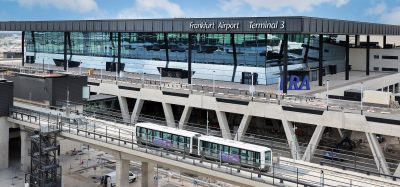Baggage handling systems experts
Posted: 16 June 2006 | Patrick Teo, BCS Group CEO | No comments yet
From ensuring airlines depart on time to delivering baggage safely and reliably to passengers at their destination, love them or hate them, baggage handling systems (BHS) are vital to the smooth running of every airport.
From ensuring airlines depart on time to delivering baggage safely and reliably to passengers at their destination, love them or hate them, baggage handling systems (BHS) are vital to the smooth running of every airport.
As the global threat of terrorism persists, the challenges facing the air transport industry are considerable; in addition to speed, reliability and cost, security is now a consideration. Created in 1993, the BCS Group today supplies approximately 75 per cent of the Australasian BHS market and is well equipped for further expansion to play a global role in the industry.
A proactive and innovative approach delivers results
Developing leading edge solutions for the industry has been our goal from day one. Our approach has been to ‘work hard under the radar’ in a structured, iterative, pro-active and innovative way. This, coupled with the ability to respond to the occasional unforeseen challenges that all industries face at one stage or another, has delivered results. successfully install and commission a Hold Bag Screening (HBS/CBS) project in Australia at the Brisbane International Terminal and in 2000, the BCS Group supplied a turnkey electrical design and control systems for the Sydney International Terminal (BHS and HBS/CBS) to meet the demand of the upcoming 2000 Olympics. 2001 saw BCS add a full suite of BHS conveyors to their range of control products on offer to become a recognised and independent BHS supplier. Their range now includes conveyors, curves, carousels, system design software, high level (SAC) control systems and a full after sales service and support infrastructure team. BCS have completed major turnkey baggage supply contracts in most of the major international and domestic Australian airport terminals.
Join us live: Shaping the Next Generation of Hold Baggage and Air Cargo Screening
Join us live for an insightful webinar on 11th December at 14:00 GMT, in collaboration with Smiths Detection, as we explore the strategic balance of operational efficiency, regulatory compliance, and sustainability in high-volume security environments.
This session offers a focused look into future-proofing your security strategy.
Key learning points
- Cost Reduction: Strategies to minimize bag travel time while simultaneously reducing operational costs.
- Regulatory Roadmap: Insights into the next wave of regulatory changes and their impact on future investment decisions.
- Sustainable Systems: Practical approaches to building sustainability into security systems and lowering the total cost of ownership (TCO).
- Scalable Solutions: Real-world examples of scalable systems supporting current airport growth and preparing for tomorrow.
Register now for expert insights, case studies, and actionable strategies on operational efficiency!
Technical expertise is the key
BCS are known for their technical expertise in the successful completion of BHS projects and a large part of this is owed to the fact that BCS started off life as an industrial automation and integration company. In a world where there are thousands of conveyor manufacturers, only a handful of companies specialise in BHS controls because of the extremely high technical requirements. In modern BHS systems, up to 50 per cent of the cost can now be attributed to software and the automation processes.
Project management pays…
Apart from the use of new technologies, BCS also recognises the need to apply strict project management principles to their projects, and have developed an in-house BHS specific PMP (Project Management Plan) that focuses on consistent and controlled delivery of BHS to the client.
…so does listening
This, together with listening to and providing what the client requires, sets the BCS Group apart from the vast majority of the competition.
An in-house 3D virtual environment allows thorough testing of designs…
As part of their drive towards excellence, BCS have developed their own in-house virtual airport environment to allow them to test their designs and controls. In what is believed to be a world first, BCS have created a 3D virtual environment where they are not only able to simulate, but can actually emulate and test the project control designs and witness the response of the systems using the actual PLC hardware and software that is being delivered to the client.
…and certainty that the software works
This allows the client to sign off on pre-installed software with 99.9 per cent certainty that the software which they have purchased is actually developed, tested and signed off against the project deliverables. In addition to the unique software testing that is done, the BCS Group have also established a complete mechanical test facility in Melbourne where new designs and equipment are tested to ensure reliability and durability.
Maintenance free safety systems
Safety is becoming more and more of an issue. BCS, as a preference, utilises a pressure sensitive cable Emergency Stop safety system in all of its designs. This product operates using a unique cable which triggers with any small deflections and offers total system coverage, up to Category 3. The cable can be run up to 10 kms along torturous routes and is monitored by a “fail-safe” control unit. Maintenance requirements are almost zero (unlike mechanical lanyard systems).
The BCS Group project approach in more detail
Step 1 – Clearly define all project requirements and expectations upfront and get it right first time
What better way to start a project than by determining all of the client requirements and expectations and ensuring that they are clearly defined and understood? BCS have developed a clear and concise project analysis tool to reduce the risk of serious error or misunderstandings on the project deliverables, that could impact on the entire project. A significant emphasis is placed on liaising closely with customers to ensure that the requirements are clearly understood, and this gives BCS the opportunity to refine original concepts to optimise the final delivered system.
Step 2 – Set the specification
An accurate and detailed Functional Design Specification is produced from the client interaction which is used to explain how the system will operate in greater detail than the requirement analysis.
Step 3 – Produce 3D layouts for clarity
BCS then produces 3D mechanical and electrical layout drawings which give the installation teams a much better appreciation for the proposed system and gives the clients a better understanding of the system topology.
Step 4 – Create a virtual simulation
From the layout CAD drawings, a simulation of the system (Virtual Airport) is created which is used to verify the design, functionality and performance using real and predicted flight data. Any identified enhancements to the original design can also be simulated and presented to the customer for approval.
Virtual Airport and Airflow – two BCS Group proprietary software applications
BCS has engineered two extremely sought after software applications specifically for BHS applications. Virtual Airport was designed and developed to minimise risk in design and commissioning. It initially works as a simulation tool to test the design, but can then be changed over to operate as an emulation tool to test the programmable logic control and SAC. Airflow is a High Level Control System used to integrate computers controlling the BHS with the electronics and other airport and airlines computer systems. Further information on the new technologies of both Airflow and Virtual Airport can be seen on the attached demo CD .
Operations and maintenance has experienced exceptional growth
BCS Infrastructure Support (BCS IS) is the Operations and Maintenance division of the BCS Group and lead the field in the provision of services to all airport terminals in Australia. This fact has been recognised by the aviation industry, with exceptional growth experienced by BCS IS over the past two years. BCS currently employs nearly 100 full time personnel to operate and maintain both BHS and aerobridges throughout Australia.
O&M practices and experience of BHS extend to all types of equipment used in the transfer of baggage, including x-ray machines, ploughs, conveyors and helix-sorters.Aerobridge O&M experience extends to passenger transfer aerobridges manufactured by Jetway, Rheem, Sam and Fokker. Continuous improvement programs are developed, evaluated, implemented and monitored to effect the change required in an ever demanding and dynamic environment such as an airport. Commitment, clarity and direction for all staff are preserved to enhance their commitment and desire to create a distinctive competency within the industry. From inception, BCS has delivered innovative solutions using best possible practices and technology, whilst focusing on achieving optimum customer satisfaction with both our service and the performance of our systems.
The BCS Group approach at work
Brisbane Airport — a case study
Brisbane Airport was first off the blocks when it came to taking up the challenge of installing 100% screening of international flights in Australia.
BCS were engaged as the head contractor to design and construct a Checked Baggage Screening System within the confines of the existing International Terminal Building, while ensuring that the BHS remained operational at all required times. BCS initially undertook a survey of the existing system and reported findings on where the efficiency of the BHS could be improved and what would be needed to be upgraded.
The design of the BHS has to allow 100% of all checked in baggage to be screened via x-ray machines. Suitable changes to the existing conveyor system were proposed and
modelled in 3D AutoCAD and then simulated using Virtual Airport. The simulation helped BCS fine tune the design in order to get the greatest efficiencies out of the BHS and also allowed BCS to view the typical operations on a busy day as well as test future growth forecasts.
BCS developed a suitable staging plan to progressively take the current operational BHS and modify it into a new improved system while keeping it fully operational and minimising the risks to Brisbane Airport.
The first stage undertaken involved installing High Speed Ploughs that moved baggage from one moving conveyor onto a parallel system. This provided for better redundancy routes in case of a failure and provided planned fallback procedures with greater options in order to get the construction completed as quickly as possible.
Stage two involved the fabrication and installation of structural steel and platforms to hold the new x-ray machines, as well as new office buildings to accommodate the additional staff required for the checked baggage screening process.
At the same time that the construction planning was underway, a team of BCS software engineers developed and tested new PLC software which controlled the entire existing BHS system whilst the existing controls were modified to accommodate the HBS requirements.
To minimise the risk to Brisbane Airport, BCS used Virtual Airport to emulate the BHS and allow their software engineers to fully test the automation software off site. Brisbane Airport staff joined the BCS software engineers at their Auckland offices to complete the factory acceptance tests, fine tune the software and approve its use before implementing it into the real BHS.
The implementation of the new hardware and software was performed overnight during nonoperational hours, sometimes limited to 4 hours between 1am and 5am when the team would load a new code into the BHS and test it, then rolled back to run the airport during the day on the original software code and hardware.
Once the new software had completed its tests, it was turned on successfully, without disruption, in a truly seamless change over.
The construction process involved supplying and installing nearly 200 conveyors and four x-ray machines, and managed to improve the efficiency of the whole BHS system. It was completed on time and within budget, without causing disruption to the airport operations.
The International Airport Summit is open for registration!
Date: 19 – 20 November 2025
Location: JW Marriott Hotel Berlin
At our flagship event of the year, we will dive into the future of airport operations, with expert-led sessions on passenger experience, innovative smart technologies, baggage handling, airside operations, data, security, and sustainability.
This is where global airport leaders come together to share insights, challenges, and real-world solutions.
Limited complimentary passes are available for eligible professionals – first come, first served!


















